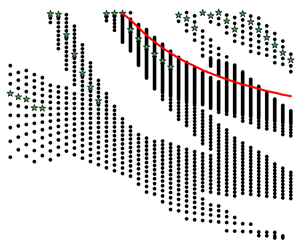Article contents
The spatial Whitham equation
Published online by Cambridge University Press: 03 October 2024
Abstract

The Whitham equation is a non-local, nonlinear partial differential equation that models the temporal evolution of spatial profiles of surface displacement of water waves. However, many laboratory and field measurements record time series at fixed spatial locations. To directly model data of this type, it is desirable to have equations that model the spatial evolution of time series. The spatial Whitham (sWhitham) equation, proposed as the spatial generalization of the Whitham equation, fills this need. In this paper, we study this equation and apply it to water-wave experiments on shallow and deep water. We compute periodic travelling-wave solutions to the sWhitham equation and examine their properties, including their stability. Results for small-amplitude solutions align with known results for the Whitham equation. This suggests that the systems are consistent in the weakly nonlinear regime. At larger amplitudes, there are some discrepancies. Notably, the sWhitham equation does not appear to admit cusped solutions of maximal wave height. In the second part, we compare predictions from the temporal and spatial Korteweg–de Vries and Whitham equations with measurements from laboratory experiments. We show that the sWhitham equation accurately models measurements of tsunami-like waves of depression, waves of elevation, and solitary waves on shallow water. Its predictions also compare favourably with experimental measurements of waves of depression and elevation on deep water. Accuracy is increased by adding a phenomenological damping term. Finally, we show that neither the sWhitham nor the temporal Whitham equation accurately models the evolution of wave packets on deep water.
- Type
- JFM Papers
- Information
- Copyright
- © The Author(s), 2024. Published by Cambridge University Press
References
- 1
- Cited by



